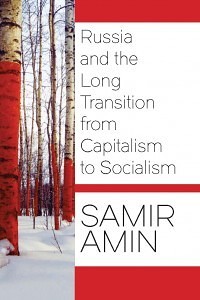Russia and the Long Transition from Capitalism to Socialism
144 pp, $23 pbk, ISBN 9781583676011
By Samir Amin
Reviewed by David M. Kotz for Science & Society, Vol. 83, No. 2, 268-270, April 2019
In this short book Samir Amin, a distinguished left intellectual with a career spanning many decades, offers an analysis of Russia and its role in the transition from capitalism to socialism. The book consists of six essays written between 1990 and 2015, supplemented by a new commentary at the end. Amin’s approach combines the Marxist theory of historical materialism with World Systems theory.
Amin was a founder of the center–periphery analysis of the global capitalist system, which places Europe and later the USA and Japan as the imperialist center, while Asia (apart from Japan), the Middle East, Africa, and Latin America make up the dominated periphery. He notes that this division arose early in capitalist history, long before the monopoly stage emerged in the late 19th century which Lenin identified as the imperialist stage of capitalism. Amin argues that the center’s domination causes economic development to be either blocked or distorted in the periphery, a view that has long provoked debates among Marxists.
A central theme of the book is the historical distinctiveness of Russia within the global system. Centuries ago precapitalist Russia formed as a state regime based in Moscow, which constructed an empire that eventually extended to Siberia, Transcaucasia, and Central Asia. This empire developed separately from the rising capitalist system of Western Europe, which established trade routes to Asia and the Americas along with colonial domination of the latter region. Amin argues that Moscow’s empire had a different character from the Western colonial empires. It did not uproot the dominated societies as did capitalist penetration. After the Russian Revolution, the USSR diverged even further from capitalist empires: while Moscow dominated politically, economic benefits mainly flowed from Russia to the other Soviet republics. While ethnic Russians had some privileges in the Soviet system, Moscow encouraged the development of local languages and cultures rather than seeking to stamp them out.
Why did socialist revolutions take place in Russia and China, instead of the developed countries of Europe? Amin’s answer is that both were major centers of world civilization; both were penetrated by capitalism in the 19th century but in a way that blocked a route to becoming a major capitalist power, and neither was fully subjugated to European imperialism. This led to tensions and contradictions that made it possible for Communist parties to come to power.
However, in Amin’s view what followed in Russia was not the construction of socialism. While the state nationalized the means of production, the social relations of production were not transformed as would be required for building socialism. The underlying cause was the early decision to pursue catching up to the capitalist west as the main priority — a decision spurred by a realistic expectation that rapid industrialization was necessary to avoid being wiped out by an attack from the west. However, if they were not socialist, why then were the new regimes in the USSR and China viewed as enemies by the dominant imperial powers? Amin argues that the reason was the economic and political delinking of those regimes from the global capitalist system, which was unacceptable to the imperial powers.
Amin disagrees with the view, popular among some on the left, that contemporary globalized capitalism has outgrown the nation–state, arguing that a global bourgeoisie is not even in formation. Indeed, the view that contemporary capitalism is becoming a homogenous and stateless global system overlooks the fact that capitalism is not just an economic system; it requires a state that monopolizes the means of coercion, which remain in the hands only of states. The capital accumulation drive does give rise to a tendency to obliterate state boundaries, but this remains only a tendency as long as the capitalist classes of the major powers are unable to merge and create a genuine global state, a development that is not on the horizon. Instead, Amin forcefully argues, since the end of World War II, a triad made up of the USA, Europe (especially Germany, the UK, and France), and Japan has been the ruling imperial power in the world, with the USA the overall hegemony.
Following the long imperialist tradition, today the triad regards any state that is delinked from the global capitalist system as an enemy. While post-Soviet Russia and post-Mao China have both been integrated into global capitalism — the former as a raw material exporter and the latter as a rising industrial power — both states are politically independent of the triad, something that cannot be tolerated. The triad pursues a strategy of bringing Russia and China under U. S. domination, while the European part of the triad turns the former Communist-ruled states of East–Central Europe and the former Soviet republics into its neocolonial.
Amin’s ultimate aim, as analyst and activist, is to chart a strategy for the liberation of the periphery regions from imperialist domination and oppression and for a transition to socialism in the periphery. He argues that achieving the former requires starting down a path toward the latter. With normal capitalist development blocked in the periphery, the only path of development that can bring improving lives for the peoples of the periphery is to delink economically from global capitalism, pursue autonomous development, democratize, and push for a world system that allows autonomous development for states. A progressive alliance of popular classes is held to be the only basis for moving in that direction.
As would be expected in a book composed of six essays written at different times, there are some inconsistencies. Amin notes that his views on some matters evolved, such as the character of the Soviet system. This shows an admirable adjustment of analysis in light of later developments, but it leaves the reader unsure about Amin’s final view on some points. For example, it is not clear whether in the end Amin views the Soviet system as capitalist or something else, and the Soviet ruling group as a bourgeoisie or something else. A strong case can be made for the view that the Soviet system was not capitalist and had some important socialist features. This interpretation can explain the extreme hostility of the Western capitalist powers, which seemed to fear the Soviet Union’s non-capitalist (and partially socialist) mode of
production, not just its delinking from the global capitalist system.
Amin’s view of the Putin regime is complex. He makes a persuasive case that an oligarchy of predatory capitalists forms the base of the regime, which accounts for the continuation of its economically destructive neoliberal policies. Nevertheless, he suggests that Putin might break from that system to pursue independent development of a progressive sort. While Putin plays a progressive role in some world trouble spots, due to the contradictions between Russia and the imperialist triad, to this reviewer it seems unlikely that Putin will break with the oligarchic system that put him in power. That system has reportedly enabled Putin and his close associates to gain great wealth, while at the same time it prevents any move away from the deindustrialize raw materials export economy that keeps the Russian people poor.
—David M. Kotz
Department of Economics
University of Massachusetts/Amherst


Comments are closed.